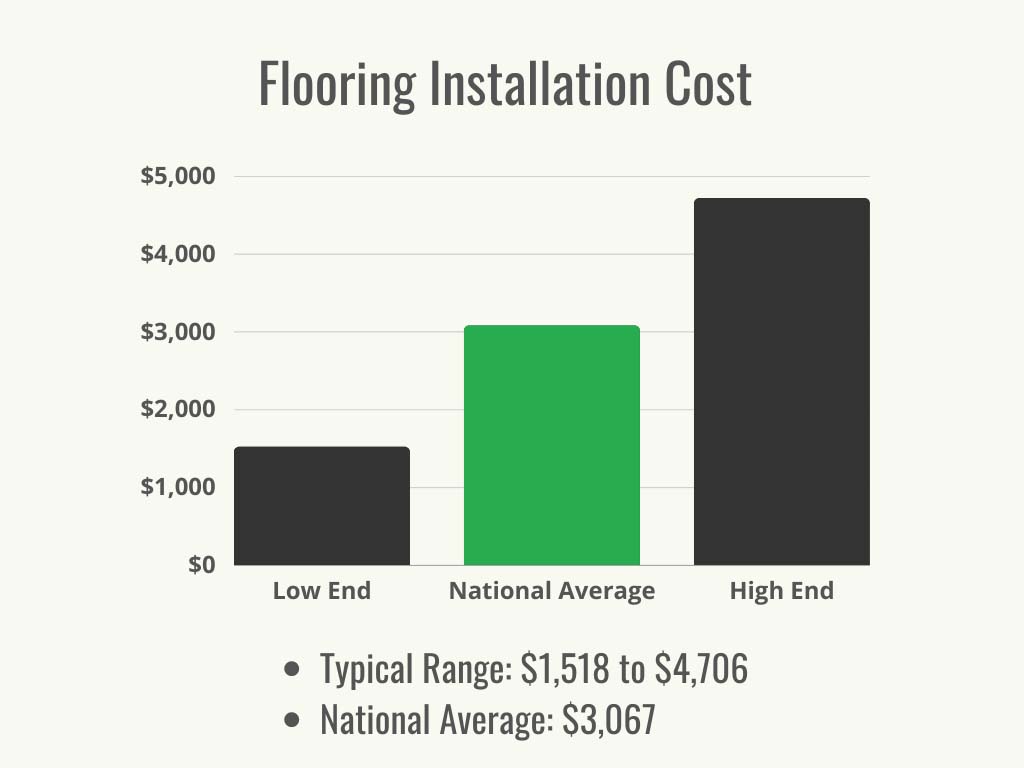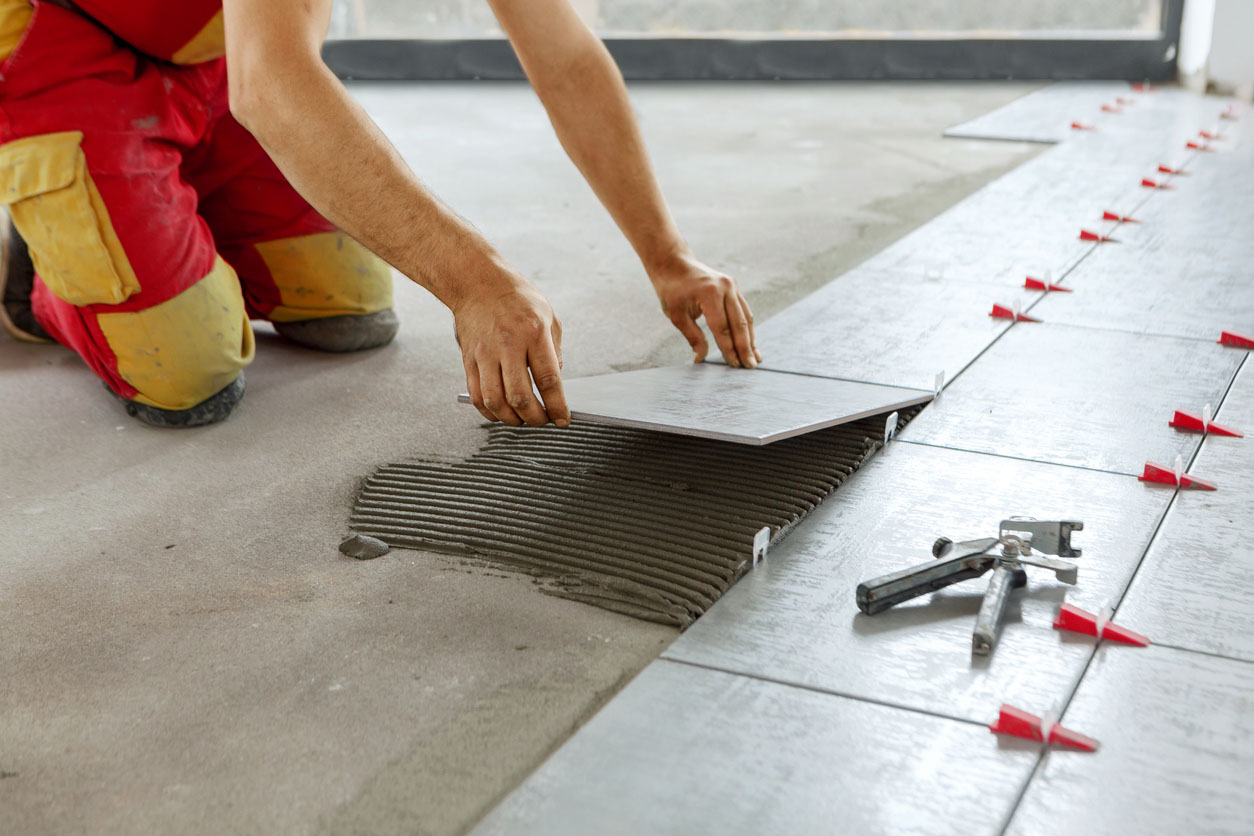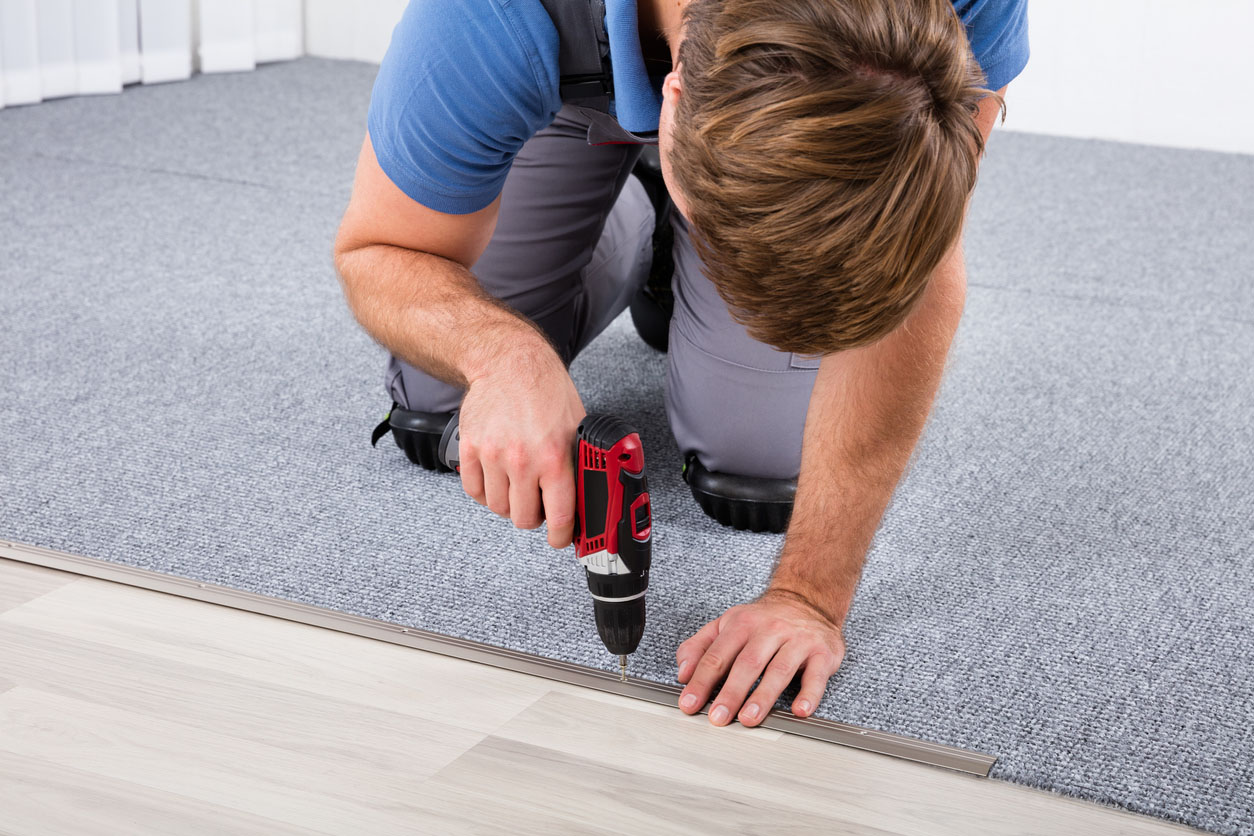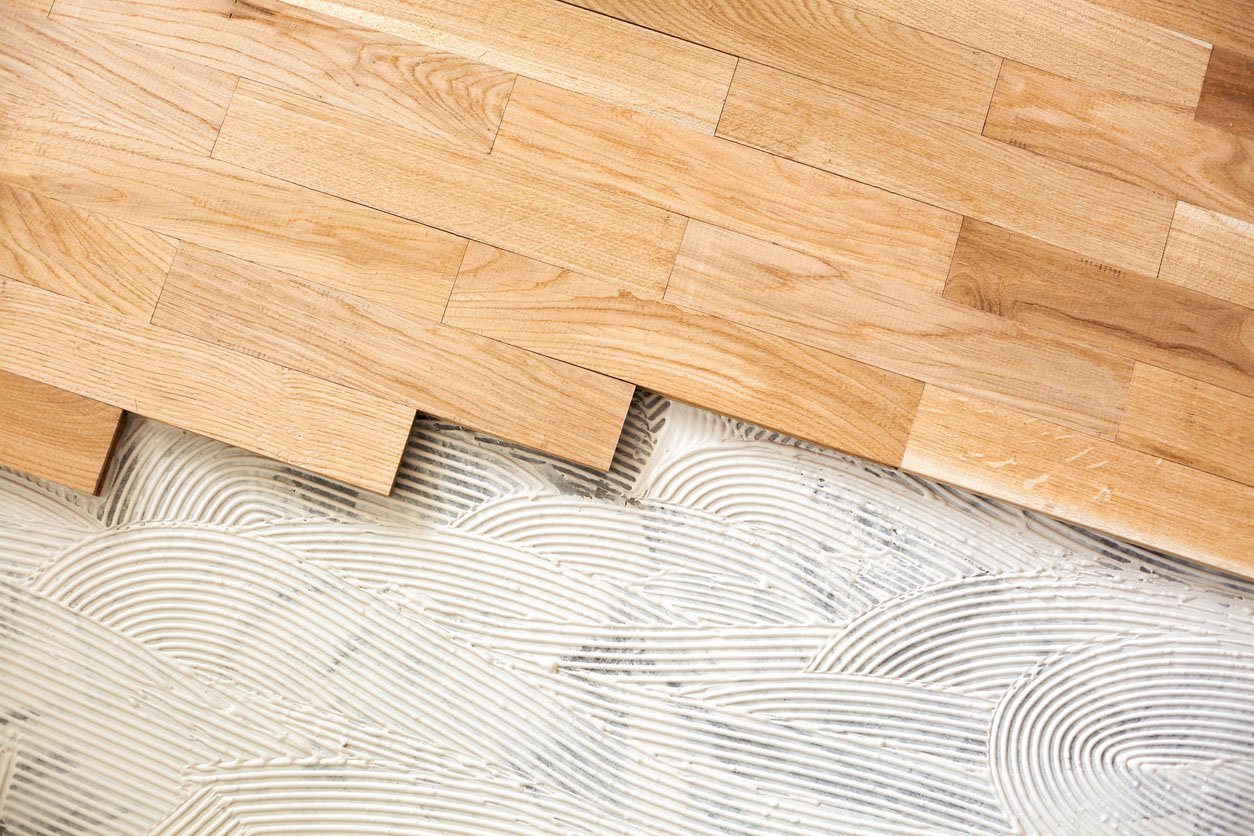

We may earn revenue from the products available on this page and participate in affiliate programs. Learn More ›
Highlights
- Flooring installation costs run between $1,518 and $4,706, with a national average cost of $3,067.
- The exact cost of flooring installation depends on the flooring material, the size of the room, and the local cost of labor.
- There are several benefits to installing new flooring, including improved aesthetics, better energy efficiency, and increased home value.
- While some homeowners may be able to install flooring themselves, hiring a professional can ensure the job is done properly and on time.
No matter what type of flooring is currently in a home, it will eventually show its age. Hardwood will reveal scratches and wear from foot traffic patterns, while carpet will fray. Whatever a homeowner’s reason for changing their home’s floors, there are many options available. In addition, knowing all the factors involved in the installation process will help homeowners understand how much the flooring will cost.
If a homeowner wants to get new flooring installed in their home, they can expect to pay between $1,518 and $4,706 for flooring installation costs. The national average is around $3,067 for 500 square feet of coverage, and this average cost includes materials and labor. However, the costs can increase based on various factors, including whether the existing floor needs to be removed, damaged subfloor needs to be replaced, or hazardous materials need to be remediated.

Carpet, hardwood, tile, vinyl, and laminate flooring.
Bob Vila has partnered with Empire Today® to help you easily get beautiful new floors at a great price.
Free In-Home Estimates
Factors in Calculating Flooring Installation Cost

Although most flooring jobs average $3,067 for 500 square feet of space, this amount may be dramatically higher or lower depending on how many square feet of space the homeowner needs to cover. This may also vary based on what part of the country the home is located in, as urban areas have a higher cost of living and, therefore, higher labor costs. Also, if the homeowner decides that they want higher-end flooring, this could drive up the costs. Another critical factor that may drive up the price is how much the installation team may charge to remove the existing floor.
Floor Material
The type of floor material chosen is the main component that will affect a flooring installation project’s bottom line. For example, the cost of installing carpet averages $3.50 to $11 per square foot, while the cost of hardwood averages $6 to $22. Natural stone, ceramic, or porcelain tiles are also pricier options, coming in anywhere from $6 to $20 per square foot.
According to Tyler Morelan, founder of Midwest Flooring Company, “In general, hardwood or tile flooring is more expensive to install than carpet, luxury vinyl or laminate flooring, and typically takes longer to install. Conversely, carpet is generally cheaper to install than hardwood flooring but requires more frequent cleaning and maintenance. Laminate flooring is typically less expensive than both carpet and hardwood flooring but does not have as long a lifespan as either option.”
Floor Size
The size of the floor is another significant cost factor; it will be cheaper to install 200 square feet of flooring than 2,000 square feet of flooring. The size of the area being re-floored will also dictate how much labor costs. While one person may install tile in a tiny area of the home such as the foyer, installing tile in a large kitchen may require more than one person.
Labor
Floor material and floor size make up a substantial amount of the costs involved in flooring installation. However, labor is another critical cost that factors into the bottom line. The cost of labor to install flooring per square foot can run between $1 to $15. Easier installations, like floating hardwood floors on an existing floor, are cheaper than more intensive jobs like gluing down planks or laying heavy tiles. If labor is required to remove flooring, this may be an additional charge, and the difficulty of the removal will also factor into labor costs. Removing a 12-foot by 12-foot carpet that’s stapled down takes about 3 hours to complete at $60 per hour. But a carpet that’s glued down is more difficult to remove and will take more time.
According to Morelan, “[R]ooms with complex layouts or difficult access (i.e those with lots of tight corners or that are located on multiple levels) may incur additional labor costs, which can drive up the overall price tag for installation as well as accessibility to plumbing fixtures or the need to remove appliances.”
“The best way to get an accurate estimate for your specific project is to contact a few reputable contractors in your area,” he advises.
Home Location and Travel Distance
If a home is located far away from the homeowner’s chosen installer or is located in a remote area, travel fees may come into play. Before booking a flooring installation pro, homeowners will want to ask if they are in their service area and find out if there are any additional costs for travel outside of their service area.

Additional Costs and Considerations
Like with any home project, there are possible additional costs that could cause the bill to be higher. For instance, an installation company may charge a homeowner to move their furniture before they install the flooring. If the subfloor is in poor condition and needs repair or replacement, this will be an additional fee. However, in some cases, a homeowner may not need these services.
Moving Furniture
One thing a floor installation team may charge a homeowner for is moving furniture. If the homeowner is capable of moving the furniture, they can eliminate this cost. Also, homeowners must remove small items and items that may shatter because most installation teams don’t move such items.
Stairs and Other Features
Another cost a homeowner may incur is the cost of installing flooring on stairs or other features in their home. For example, if the homeowner wants carpet installed on their stairs, they can expect to pay between $3.50 and $11 per square foot and $11 to $160 to carpet each step. Hardwood installation on stairs will run you about $160 per step.
New Subfloor and Baseboard
The subfloor is located underneath the flooring, and therefore, it’s difficult to know if anything is wrong with it until the flooring is removed, though, according to Morelan, “There are a few key signs to look for that indicate a subfloor will need to be repaired before installing a new floor.” The first sign has to do with water damage. “If the subfloor has been wet in the past, it’s likely that it will need to be replaced or repaired,” explains Morelan. “Another sign is if the floor is noticeably uneven or if there are soft spots under foot. This can be a sign of rotting wood and/or moisture damage,” he adds. “If you see any of these signs, it’s best to have a professional inspect the subfloor to determine whether it needs repair or replacement.”
Fixing certain areas of the subfloor or replacing them entirely will tack on additional costs. On average, a new subfloor will cost $2 to $2.50 per square foot. In addition, if the baseboards are damaged, additional charges may be incurred for removal and reinstalling new ones.
Underlayment
Underlayment is typically not required for hardwood, vinyl, or tile. However, it is generally necessary for carpet and laminate. Underlayment is primarily used as a moisture barrier between the subfloor and the flooring. But it can also help with adhesion, minimizing the sound of footsteps and providing a smooth, comfortable surface. If underlayment is needed, homeowners can expect to pay an additional $3.40 to $5.30 per square foot of underlayment.
Removing the Existing Floor
It’s possible that some flooring can be installed over old flooring. However, most flooring manufacturers recommend that the old floor be removed first. This is a prudent idea because there may be a hidden problem with the subfloor. Also, the new flooring may make the floor too high, which can cause problems with opening and closing doors. The cost to remove existing floors varies according to the type of existing floor but ranges between $1 and $6 per square foot on average.
Hazardous Material Testing and Remediation
If a floor installation team suspects or discovers hazardous materials during the removal process, they can’t proceed with the installation until the harmful material has been removed. When it comes to mold or asbestos, a homeowner will have to pay a special team to remove the material before the flooring installation can continue. Mold remediation costs between $10 and $25 per square foot, while asbestos removal costs $5 to $20 per square foot.
Finish
A floor finish is recommended for natural stone, wood, or concrete and will keep floors in good condition, even in high-traffic areas. Costs to seal these floor types range between $0.85 to $7 per square foot.
Additional Materials
Aside from floorboards that may need to be replaced, additional material a homeowner might be charged for could include transition strips. These decorative accents not only make the floor look better but also prevent cracking, fraying, or chipping between flooring types in the home. A floor installer may fit a Z-bar or hardwood trim between two floor sections to hide the join.

Types of Floors
While the national average cost to install flooring is $3,067, this cost may fluctuate based on the type of floor a homeowner decides to have installed. Hardwood is one of the pricier options, starting around $4,000 for installation. For a more affordable wood option, homeowners can choose between engineered wood or laminate. Or they can choose an entirely different flooring type, like carpet or tile. Below are the most popular types of floors that homeowners have installed in their homes.
Hardwood
Hardwood floors are one of the most popular choices for flooring. Wood flooring costs run between $4,000 and $29,000 for 1,000 square feet. However, the type of hardwood and the grade may drive these costs up or down. Pine is one of the more affordable options, while more exotic woods like Brazilian walnut and cypress top the price bracket.
Laminate
Laminate is a type of synthetic flooring made to resemble hardwood. It is essentially wood particles attached to an image of wood with a transparent layer on top. Laminate wood flooring delivers the look of hardwood at a fraction of the cost. Installing laminate flooring costs about $9,350 for 1,000 square feet.
Engineered Wood
Engineered wood is very similar to laminate wood. The difference is that it is bound to a thin veneer of natural wood instead of an image. As a result, engineered wood is more durable and may come in various widths that aren’t available with solid wood. It is also more affordable than hardwood. However, the number of times engineered wood can be refinished is limited because of how thin the veneer is. Engineered wood costs between $4 and $16 per square foot.
Tile
Tile flooring is a popular option, particularly in kitchens, bathrooms, and foyers. The common types of tile flooring are ceramic, porcelain, glass, marble, and granite. When it comes to tile flooring installation costs, homeowners can expect to pay between $6 to $20 for natural stone and between $15 and $20 for porcelain or ceramic.
Carpeting
Another popular flooring option is carpeting. It became trendy after World War II but has dwindled in popularity in recent years due to increased interest in hardwood floors, which have become more chic, affordable, and durable. Carpet installation costs between $3,000 to $22,000 for 1,000 square feet. Materials alone run between $2 and $7 per square foot.
Stone
Stone is becoming increasingly popular, especially in kitchens and bathrooms. There are many types of natural stone, such as marble, granite, limestone, quartz, and quartzite. Engineered stone is also gaining popularity in house areas like the bathroom because it is more slip resistant than other stones. The cost to install stone tile is between $6 and $20 per square foot.
Vinyl and Linoleum
Vinyl and linoleum are similar materials, but vinyl is more popular and durable, and linoleum’s heyday is in the past. Vinyl is a completely synthetic material, and linoleum is made primarily from linseed oil derived from flaxseed. While vinyl is considered more resilient than linoleum and requires less upkeep, eco-conscious consumers might prefer linoleum as it has less impact on the environment. Vinyl and linoleum flooring cost between $1,500 to $20,000 for 1,000 square feet.

Do I Need a New Floor?
There are many different reasons you may want a new floor. One reason may be because you are tired of the outdated flooring that you currently have installed. Another reason is that you might be trying to sell your home and a stager suggests that you change the floor to avoid distracting potential buyers. And finally, sometimes you need a new floor because there are problems with your existing floor.
The most common problem with the floor will be general wear that comes from years of use. There may be floor areas that are much more worn than others, particularly in the case of wood floors in foyers or frayed carpets where the kitchen and the living room meet. Other problems could be excessive squeaking or cupping of wood floors due to recent water damage.
Old and Outdated Flooring
According to Morelan, “There are a few tell-tale signs that you may need new flooring installed in your home. One of the most obvious is if your current flooring is starting to look visibly worn down, such as scratches, tears, or fading.”
Having old flooring is a significant reason to replace your floors, especially if you have carpet. Carpet typically lasts from 5 to 15 years with the proper care and maintenance. If the floor has excessive stains, foul odors, tears, or burns, then it’s a good idea to replace the carpet. Also, if you suspect that the carpet may be causing respiratory illness, it may be prudent to replace it. Carpet isn’t the only old flooring you need to replace. If you have parquet floors from the 1960s or vinyl from the 1970s, it may be time to replace those floors, too.
Unevenness, Cracks, Peeling, and Soft Spots
According to Morelan, “Another sign can be detected by feeling the surface of the floor; if the flooring feels spongy when you walk on it, or if the flooring is starting to come up at the seams, this is usually an indication that it’s time for a new installation.” This might indicate that not only is your flooring damaged but your subfloor may be suffering from moisture damage also. Soft spots may even suggest a problem with pests. The only way you will know for sure is to have a flooring contractor remove the existing flooring to discover the root of the problem. But if the floors are cracking or peeling and it’s concentrated in one area, you may be able to refinish the floor.
Noises and Smells
Over time, houses develop various types of smells. But one that you should never ignore is a consistently musty smell. This usually indicates mold or mildew. Most of the time, this growth is between the flooring and the subfloor. In such cases, you will have no other choice but to replace the flooring to solve the moisture issue and get rid of the musty odor. Likewise, if you hear a substantial amount of squeaking, this may indicate problems with the subfloor that need to be addressed before laying down new flooring.

Benefits of New Flooring
The main benefit of getting new flooring is because you need it. Outdated styles, stains, burns, cracks, and general wear take their toll on floors. Getting an updated design or changing the style altogether will make you feel better about your home’s overall decor. Here are some other benefits of getting new floors.
Increased Home Value
Flooring installation can be a tedious process that many prospective buyers may not want to take on, so new floors can be a boon for buyers and increase the selling price for sellers. Installing a hardwood floor can increase the value of your home by about 2.5 percent, and the average return on investment (ROI) for new floors is 70 to 80 percent.
Improved Look
One of the most apparent reasons to get a new floor installation is because of how beautiful it will make your room look. No matter the material, new flooring makes a whole space feel new without buying new furniture or doing a major renovation.
Health Benefits
It may be surprising, but swapping out old carpets may have health benefits. According to the American Lung Association, carpets can hold on to pet dander, mold spores, lead, and other toxic pollutants that can impact your health. So replacing the carpet or getting a different type of flooring altogether can improve the health of a home’s residents.
Increased Efficiency
You may have heard that replacing doors and windows increases your home’s energy efficiency, but did you know that new floors can also improve energy efficiency? Carpets can help keep heat in your house, which is especially helpful during cold winter months. Wood, stone, and tile also help regulate a home’s temperature, keeping it warmer in winter and cooler in summer.
Flooring Installation: DIY vs. Hiring a Professional
Installing a floor yourself can be much cheaper than hiring a professional, since the cost of hiring a pro costing between $1 to $15 per square foot. While it may be tempting to do floor installation based on lower prices alone, this shouldn’t be the only factor you consider. “There are a few things homeowners should watch out for when installing flooring themselves,” explains Morelan. “For example, if the flooring is not properly sealed, it can allow moisture to seep in and cause damage to the subflooring. Another mistake people often make is not accounting for expansion and contraction caused by changes in temperature and humidity. If the flooring is not installed correctly, it can buckle or warp as a result of these changes.”
Installing floors, especially hardwood, can be a complex process. Not only do you have to acclimate the wood for a few days before installing it, but you also must use the proper equipment to make sure that the subfloor is within the appropriate moisture range. Failure to take these precautions and others that professionals are aware of can lead to moisture issues with your hardwood in the long run. “Hiring a professional installer has several benefits,” says Morelan. “They will have the experience and expertise to ensure that the flooring is installed correctly and without any major mistakes. They will also have access to special tools and equipment that most homeowners do not have, which can make the installation process much easier.” Therefore, it is often a good idea to get a well-vetted professional floor installation team to do the job when installing floors. Search for “flooring companies near me” to kick-start the process.
How to Save Money on Flooring Installation Cost
Flooring installation is a significant investment that can bring immense value to your home, whether you want to sell it or not. Flooring costs can add up. There’s no reason to have to pay for unnecessary expenses, and it’s always nice to find ways to save. Here are some ways to save on flooring installation.
- Shop around. Get multiple quotes from flooring suppliers and installers.
- Look for deals. Keep an eye out for any seasonal discounts.
- Do the prep work. For example, you can move furniture yourself rather than pay someone for it.
- DIY some of the work. Ask if you can do any part of the flooring removal yourself.
- Go with a cheaper option. Choose more affordable materials, like engineered wood instead of an exotic hardwood floor.
- Talk to your neighbors. If other homes in the neighborhood were built around the same time and your neighbors are looking to install new flooring, ask the installer about a referral discount.

Questions to Ask About Flooring Installation
New flooring is a hefty investment, and as a homeowner, you want the best results money can buy. It is an excellent idea to do your due diligence and thoroughly vet the contractors who will work on your floors to get the best results.
Many big-box stores like The Home Depot, Empire Today, or Lumber Liquidators have professional installers they work with who are licensed and insured. Whether you choose to work with their recommended installers or select your own, you should ask as many questions as possible. Below are a few of the most critical questions to ask.
- Are you licensed and insured? Many states do not require flooring installers to be licensed, but this extra level of accreditation may be more appealing to prospective customers.
- Will you provide me with a bid instead of an estimate? Estimates are approximations, whereas bids are more concrete.
- Is existing floor removal included in the installation costs? You’ll want to know if there is an additional cost associated with removal.
- Do you move furniture, and is that an additional cost? Many companies will charge for the labor of moving furniture.
- Is cleanup and disposal of old flooring and debris included in the costs? This varies from company to company.
- How long will the job take?
- How many workers will the job require?
FAQs
There are many moving parts with the floor installation process, which can equate to various costs. During the floor installation process, there may be other costs that arise, such as including underlayment for carpet or laminate. In addition, there may also be post-installation activities that you may be charged for, such as adding a finish to hardwood or natural stone. While this guide covers much about the various costs involved in floor installation projects, below are some of the most frequently asked questions about flooring costs.
Q. How much does it cost to install 1,000 square feet of hardwood flooring?
Installing 1,000 square feet of hardwood will cost between $4,000 and $29,000 and may fluctuate up or down based on the grade or type of wood selected.
Q. How do you estimate flooring installation costs?
You can calculate a rough estimate of how much your flooring installation will cost by knowing how big the room is in square feet, the type of material, and the cost per square foot of the material, as with the example above. However, having the flooring removed and trim added may add additional fees.
Q. How long does it take to install flooring?
Most flooring takes about a day to install. If the existing flooring has to be removed and this presents some difficulty because the floors are glued down, this may extend the installation length by a day. Hardwood flooring can take between 1 and 3 days. However, with hardwood floors, keep in mind that they must acclimate to the home’s internal temperature to keep from being damaged during installation. Therefore, the installers will usually deliver the wood 3 to 4 days before installation begins.
Sources: Angi, HomeAdvisor, Forbes, Thumbtack
